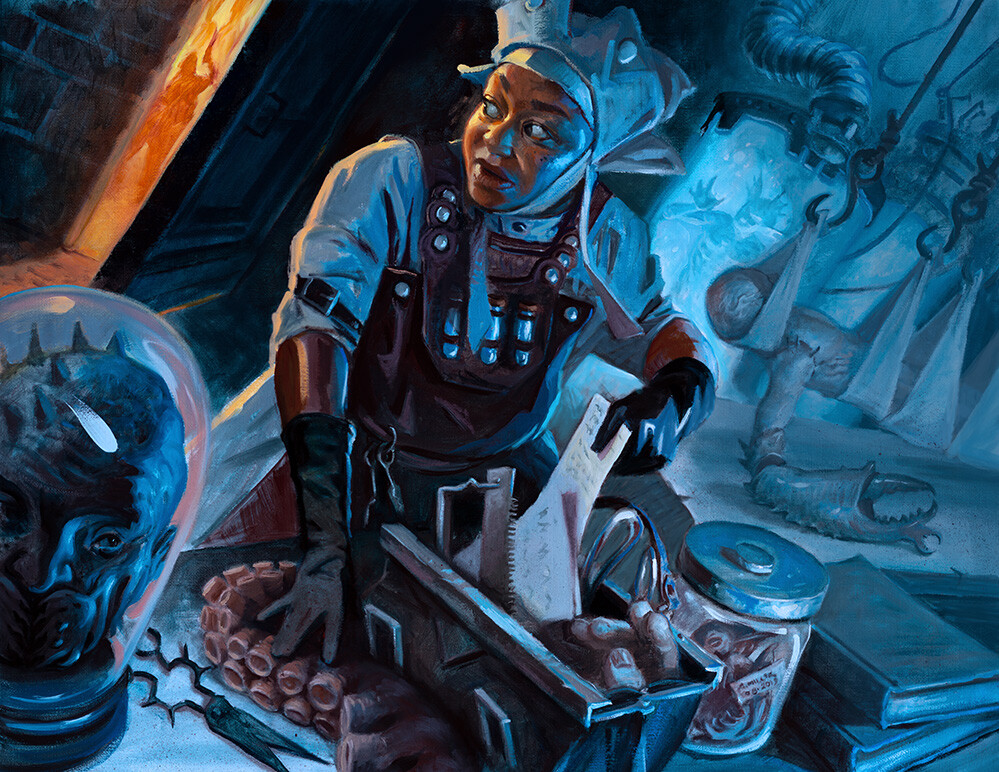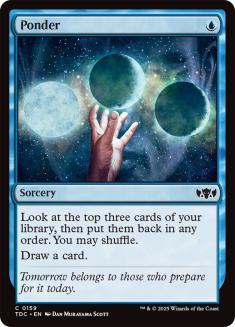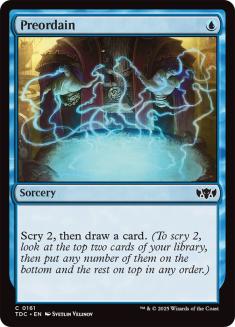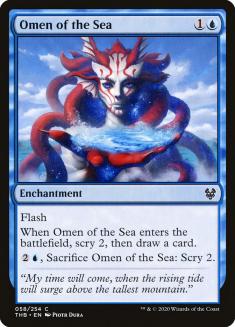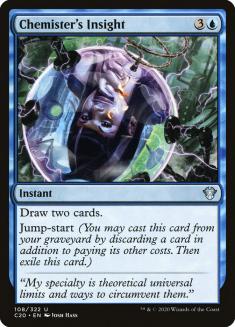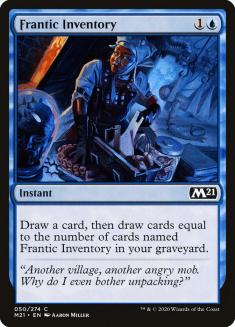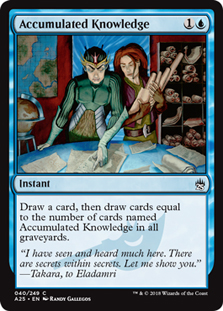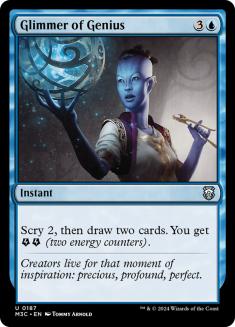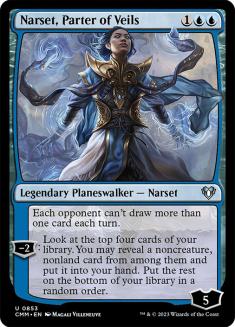For us control pilots that have been around for a bit, we have accepted that card draw will never be as good as it was in the olden days. To feel the true power of blue card draw, one must venture all the way back to Legacy. The powerful card draw printed in the last decade was a flash in the pan of Standard, only to be removed immediately from Modern right from the start. Ponder and Preordain were rightfully removed from the format prior to the first day, due to the obvious, overpowered combo decks lurking behind the scenes.
There is an argument, one made by me on a regular basis, to free these card draw spells now, but it has fallen on deaf ears. The looming fear of strong cantrips giving the best decks maximum consistency keeps this pair on the banned list; however, I am confident that one day the shot-callers at the top will see the error of their ways. Modern will never be the fair, mid-game format they want it to be and allowing the blue decks to have their cantrips will only enhance game-play. With the London Mulligan Rule, the effectiveness of cantrips has diminished some. This does not mean that Ponder, Preordain, or any future blue card that replaces itself will not be great, but it does mean this type of action is not as powerful as it used to be.
Due to the continued weakness of blue cantrips, I began building control decks very differently over the last few years. Before this new mulligan rule and when blue card draw was still reasonable, it was mandatory to incorporate some to accomplish basic control requirements. Hitting land drops early, and developing card advantage late, are the quintessential aspects of control success. Ponder, Preordain, Serum Visions, Omen of the Sea, and Opt are perfect examples of the former, hitting land drops in the early-game. The moment a control deck misses a land drop in the early-game, it is essentially over. Aggressive decks can easily miss their third land drop and continue to apply pressure, where the control player usually is holding seven cards with very few options at their disposal.
The list of early card draw takes a giant leap, from some of the most powerful of all-time, to what we have available to us right now. Opt and Omen of the Sea are a couple of Standard-legal cards that see extensive play in the older formats as well. Azorius Control in Pioneer and Modern both use Opt as its cheap blue cantrip. Modern uses a card pool that has over fifteen years of age to it and the best it can do is Opt for blue control decks. I mentioned that Ponder and Preordain were around in that time frame and were banned, but even counting them that is only three options in that class of card over such a long stretch of time. Looking at the timeline of control heavy hitters, the shift away from draw-go, permission gameplay is evident. I have always said that I understand why it was done and know, deep down inside, it was better for the game. Control was too good for too long and a big reason is the strength of blue card draw, providing a level of consistency that no other archetype was able to produce back then.
I am always frantically sifting through the previews of an upcoming set and did not have a lot of faith in Core Set 2021 for the control team. Core sets are generally weak for strategies I enjoy, and I was hoping to see a decent Planeswalker to supplement the already strong tap-out control decks in Standard. As far as card draw was concerned, I already conceded that Omen of the Sea is the cantrip for the early game moving forward and card advantage will have to come through the same tap-out plays that have been used for years. Hitting a bunch of creatures with a Shatter the Sky or nabbing and returning something with an Elspeth Conquers Death represents the new norm. Cards like Chemister’s Insight sometimes see play, but it is usually incorrect to do so. There is not time to sit back, draw a couple cards for four mana, and hope the battlefield stays manageable on its own. Magic in Modern, Pioneer, and Standard has nonstop haymakers hitting the stack, requiring card draw to be a side effect, or an early-game throwaway. With this new reality, I did not think any card draw spell could get through the anti-control vetting process and make a splash across the competitive formats. It turns out, I was very wrong.
Frantic Inventory is the triumphant return of Accumulated Knowledge, only with a new name for an obvious, eight-copy reason. Accumulated Knowledge has not been legal in a relevant format since I was a young man starting college, which was a very long time ago. I remember saving up for a couple copies of Intuition, just to live the control dream against the casual crowd at Old Dominion University. Sitting in the Web Center, drawing all the cards, while my opponent was playing silly creatures, is a memory that still makes me smile. Accumulated Knowledge has not been a legal option for anyone to play in the competitive scene for many years, so Frantic Inventory will be a delight for those who enjoy keeping some mana open on their opponent’s turns.
Preordain and Ponder are much better than Frantic Inventory is, but who cares. This is the best blue card draw spell that Standard has scene in many years and that is with cards like Glimmer of Genius in mind. Even though Glimmer of Genius was heavily played the entire time it was legal, Frantic Inventory is a stronger card all around. Mana cost and card type is everything these days in Standard. Frantic Inventory as a Sorcery, or costing more mana, would be unplayable. I fully expected a card like this to return to us in a useless form, as all the other card draw spells of old have. Wizards has moved away from blue control dominance, which explains the unlimited reprints of Anticipate, Divination, and Opt. Those spells are the best that we were going to get, which is the reason why I am still shocked at the sight of Frantic Inventory. Not only did Wizards break their instituted power level rule for blue decks, they did so with one of the most iconic draw spells of all-time.
Frantic Inventory does so much more than help with land drops in the early-game. Omen of the Sea will still be cast alongside this, thanks to our eighty-card Companion requirement, so no need to compete for the spot. If it were a competition though, it would be close. Omen of the Sea has a Scry 2 built-in, making it a superior option for hitting that third or fourth land. Another benefit is its synergy with Yorion, Sky Nomad, but that is not a defining reason to play one card over another. The mid and late-game is where Frantic Inventory blasts past Omen of the Sea.
Casting the second Frantic Inventory will be one of the most satisfying game actions my newer colleagues will ever take. For those that had some experience with Accumulated Knowledge, you know exactly what I am talking about. Drawing two cards for two mana is something that control players have not been able to do, in any of the competitive formats, for far too long. Omen of the Sea gives you that one quality card, but that is not a replacement for brute card advantage. The third and fourth copy are floating around in your control deck and will eventually be drawn, yielding a type of card advantage that has been foreign to control decks. Glimmer of Genius and Chemister’s Insight have replicated that Instant-speed, hand-filling action; however, the mana cost increase was significant. There are rarely opportunities for multiple spells, disruption, and card draw, or sometimes the fourth land does not arrive on time. It is hard to quantify the advantage of a two-mana card draw engine to a four-mana competitor, since the expensive option will have a bit more upside, but you will know after testing it out. The only concern I have for Frantic Inventory is its new role in an eighty-card deck.
The math changes some with Yorion, Sky Nomad at the helm, but I believe Frantic Inventory will still be great. With eight copies of early cantrips, blue-based control decks will see a large portion of their deck, as quick as the sixty-card variants with less cantrips. Yorion, Sky Nomad shattered the taboo of running a deck with more than sixty cards. Land drops are still met, sweepers are on-time, and win conditions are found in a timely fashion. Putting twenty more cards in our control decks did not force the train off the tracks, but instead allowed us to play every control card we wanted. Less cuts, with more power, is the state of control today. This does not just apply to Standard, but to Pioneer and Modern as well. Yorion, Sky Nomad has revolutionized the competitive control world and cards like Frantic Inventory, that want a smaller deck size, will still have a home.
Time will tell if we have returned to the days of classic card advantage. We have become used to our Planeswalkers keeping us ahead in the hand size race. Cards like Narset, Parter of Veils and Teferi, Time Raveler give us what we need early on, but they will not be around for much longer. Standard continues to rotate, which is why I am very happy to see Frantic Inventory enter the database. As far as older formats, those Planeswalkers will still be around, but there is a stronger desire to keep mana open as much as possible. Planeswalker usually require us to tap all our mana the turn they arrive, where Frantic Inventory provides another way. Decks can be built in a more reactive way if the metagame requires it. This effective reprint could be a sign for better control options to come soon, providing this old man a renewed level of optimism in the process.

